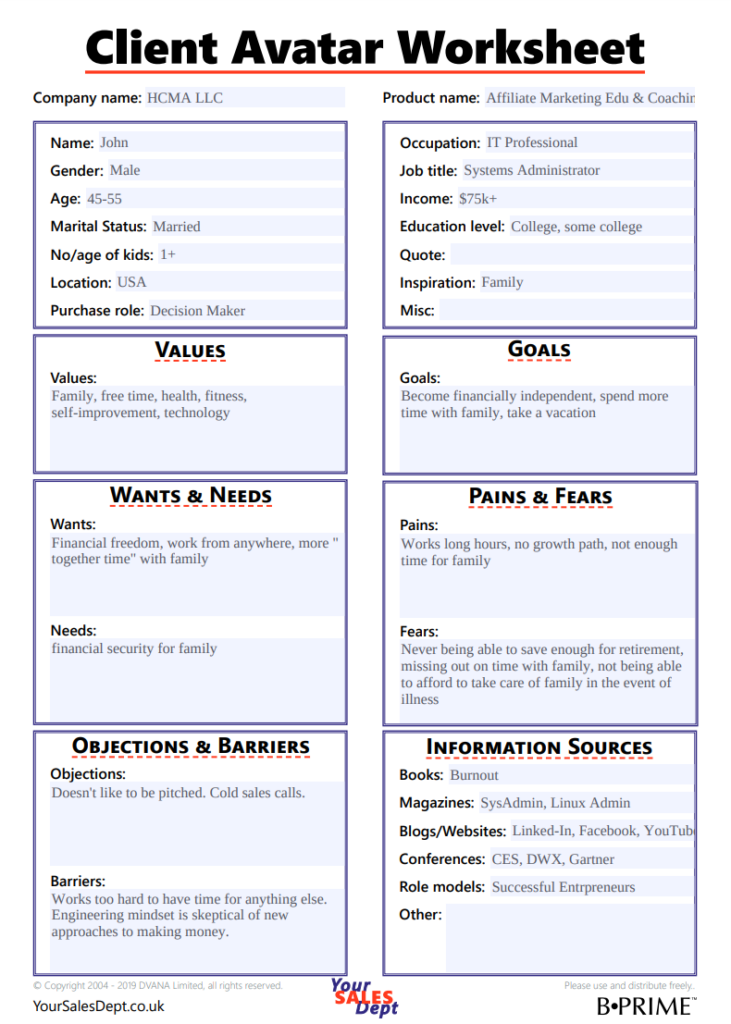Something often overlooked in the affiliate marketing world is the exercise of defining your ideal customer.
Who is your ideal or dream customer?
Who will get the most value from your offer?
Did you make a critical mistake and not identify your dream customer?
You can easily answer those questions when you make a customer avatar for your dream customer. These are also commonly referred to as client avatars. Despite the differences in nomenclature, they accomplish the same goal.
The more specific the avatar is, the clearer your messaging and offers will be for your ideal customer.
What is a customer avatar?
A customer avatar is a fictional person that represents the real human customer you're targeting.
The customer avatar includes information such as demographics, psychographics, and their goals. It can also include data on what they currently do, how much money they make or spend in a month, etc.
In short: A customer avatar helps you, an affiliate marketer, to stay focused on your customer.

The 5 major components of a customer avatar
The customer avatar can be broken down into five major components that are essential to success:
- The customer's goals and values
- What they want and need from a product or service
- What their pain points are (problems)
- How they behave in relation to your products or services, including purchase behaviors, customer feedback etc.
- The context of how you will communicate with them about your offer via email marketing campaigns, social media posts, blogging etc.
Why do you need a customer avatar?
As an affiliate marketer, you have no choice but to stay focused on your customer if you want to be successful. Which means that customer avatars are crucial tools in any marketing campaign.
A customer avatar helps you ensure you're targeting the right person with the best offer. It would not make sense for someone who is a Jeep Wrangler enthusiast to receive an offer for Toyota Land Cruiser parts.
Having a realistic idea of what your target audience is like will help you create more effective messaging, offers, sales pages and blog posts. Everything included in every step of your funnel process needs this type of attention too.

How to create your own customer avatar
Let's get started with defining your customer avatar. Rather than reinvent the wheel, I will focus on the content that you need, rather than the specific template. There are several excellent resources for templates. To get you started, here is one that I use:
Client Avatar Worksheet from Your Sales Dept.
Start by identifying your customer's demographics and psychographics.
What is the average age?
Do they have children or not?
How much money do they earn a year?
These questions will help you create more targeted messaging because if someone has kids then maybe an offer of parenting advice would be something that resonates with them. However, if their salary is low, they might consider that service too expensive!
Next determine what pain points your customer may have in relation to your products/services.
Is there anything specific about this person as far as where they live (to know which country) or how often they shop (every day or once a month)?
Create customer persona examples by analyzing your customer's customer journey.
Finally, add more information like their social media handles and the context in which they will be communicated with such as email marketing campaigns, social media posts, etc.

Examples of customer avatars in action!
I have compiled some great real-life customer avatar examples to give you an idea of what we're talking about here. You can find them below:
Example One – ENTRE Institute
ENTRE Institute is an online education company that provides digital learning solutions for entrepreneurs. The company has had tremendous success and growth in the online education space. Due in large part, to its clear customer avatar: the entrepreneur. ENTRE created a system of core values that is practiced from the top down. From the founders, to the staff, all the way down to the students. Their customers are their students, who are attracted to their core values and commitment to excellence. Their avatar consists of people that are willing to strive for excellence in all that they do. And who are driven to do what it takes to become successful in the digital economy. The end goal is achieving an awesome life for themselves, their families, and generations to come.
Example Two – Deloitte Consulting Services
Deloitte is a consulting company that helps clients solve complex problems across sectors ranging from healthcare and consumer products to automotive manufacturing and aerospace. The company has had repeat customers for over 100 years due to its customer-centric avatar approach. As a result, it has retained large clients ranging from Boeing, to GM, to Microsoft.
Example Three – Etsy
Etsy's customer avatar encompasses young women with money to spend. Typically females ages 18-35, but also older generations that buy crafts from the creative community. Approximately 86% of Etsy's customers are women.
For marketing strategies, Etsy relies heavily on customer reviews, SEO, and content marketing.
Example Four – Starbucks
Starbucks customer avatar is based on customer needs and brand image perception. It includes information such as how often they shop with them (loyalty program), their psychographics and demographics, etc. It also considers the context in which it will communicate to this customer. Such as through email marketing campaigns, social media posts, or blogs. Starbucks encourages their customers to share their experiences on social media with pictures of them drinking coffee at their local Starbucks.

Conclusion
A customer avatar is a fictional person that represents the customer you're targeting for your marketing campaigns.
As a result, this gives you valuable insight into what types of content would be most appealing to them. While ensuring you stay focused on your target customer's needs at all times in order to better connect with potential customers.
By creating personas around who it is you're targeting, this will help to improve customer engagement and conversion rates.